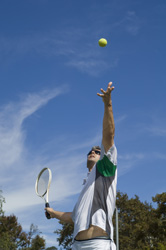Hand-eye coordination using force feedback as well
The human sense of touch is critical to our interpretation of and interaction with the world around us. As a person interacts with the environment through their sense of touch, resulting actions are modified by perception. Haptics is the term referring to sensing and manipulation through touch. Although it was first applied to humans, it now includes all aspects of information acquisition and object manipulation by humans, machines (mimicking or augmenting human touch) or combinations of the two (virtual touch, as computer graphics have done for sight). Understanding and modelling haptic interactions is important to the development of touch screen electronics and video games of virtual athletic events such as soccer and tennis.Haptic interactions are also very important in a variety of tasks requiring hand-eye coordinationFor example, a surgeon controlling a robotic arm may rely on a haptic system to transmit the force felt by the instrument to the hand holding the manipulator. This promises to achieve greater precision. Virtual environment-based training in fields such as medicine or flight training is another important application. Scientists in Turkey initiated the EU-funded project ‘The haptic e-model: A computational model of human sensory-motor performance in haptic manipulation’ (Hapticemodel) to develop a computer tool for evaluating the performance of haptic systems and human operators. Scientists developed models of human arm dynamics and inter-subject variability due to differences in haptic interfaces in order to develop benchmark haptic manipulation tasks and performance measures. Although the project was terminated early important progress was made in the modelling effort. Insights were gained regarding sensory-motor perception and haptic interactions with important applications to video games, medicine, robotics and aerospace flight training.



